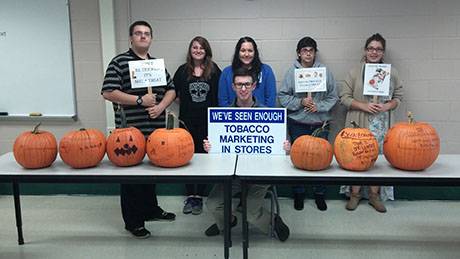
(Photo submitted by Kevin J. Keenan, community engagement coordinator for Tobacco-Free GLOW)
Press release:
Genesee SADD Council students took part in an awareness activity at BOCES earlier this week centering around Halloween and tobacco-prevention initiatives. They want to advance tobacco-free communities.
Roswell Park Cancer Institute established a tobacco-free community outreach program in 1993 and today administers three programs in Western New York: Tobacco-Free Chautauqua, Cattaraugus and Allegany (CCA); Tobacco-Free Genesee, Livingston, Orleans and Wyoming (GLOW) and Tobacco-Free Erie-Niagara (EN). Each locally based program is funded by the New York State Department of Health/Bureau of Tobacco Control.
Its goals are to prevent youth tobacco use through the Reality Check Youth program; raise awareness about tobacco control policies; and to reduce tobacco use among adults across this region and in New York State.
Reduce Tobacco Marketing Point of Sale: Product marketing and price promotion aimed at youth are proven causes of youth tobacco use. Much of this marketing occurs at the point of sale (POS) in the retail environment and may be largely unnoticed by adults.
Increase Tobacco-Free Outdoor Areas: Tobacco use in outdoor areas such as parks, playgrounds, beaches and workplaces is dangerous to the environment and presents a health risk to non-smoking adults and children.
Expand Tobacco-Free Multi-Unit Housing: Smoke-free housing protecting residents’ health by reducing exposure to secondhand smoke. Property managers benefit from reduced maintenance costs and decreased fire risks.
Decrease Tobacco Use Imagery: Research shows that smoking in movies and other media impacts teen perceptions of smoking norms and raises the likelihood of youth initiation.
Tobacco use remains the leading preventable cause of death and disease in New York.
Adult Smoking Rates
- Genesee: 18.7 percent
- Livingston: 16.9 percent
- Orleans: 29.9 percent
- Wyoming: 22.3 percent
*Source:
New York State Department of Health – based on the most recent data (July 2009-June 2009)
